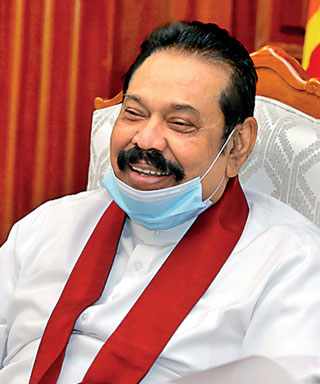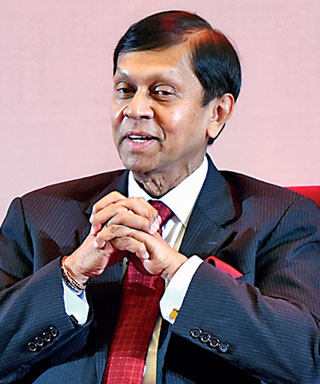Tuesday Dec 09, 2025
Tuesday Dec 09, 2025
Monday, 13 December 2021 01:29 - - {{hitsCtrl.values.hits}}

President Gotabaya Rajapaksa

Prime Minister Mahinda Rajapaksa

Finance Minister Basil Rajapaksa

Central Bank Governor Nivard Cabraal

Secretary to President Dr. P.B. Jayasundera

Treasury Secretary S.R. Attygalle
|
 Falling forex reserves
Falling forex reserves
Sri Lanka’s foreign exchange reserves are falling dramatically month after month. According to the data released by the Central Bank last week, foreign exchange reserves have declined from $ 2.3 billion at end-October to $ 1.6 billion at end-November.
When one deducts the gold reserve and the position with the IMF, the immediately available liquid reserves are marked at low $ 1.1 billion, just sufficient for paying for a little more than two weeks of future imports. Along with this, the Central Bank’s net foreign asset position has been estimated to have risen to an all-time high negative position of $ 1.9 billion, up from $ 1.3 billion a month ago. This is an extremely critical situation about which the independent writers had repeatedly warned the Central Bank’s management. But the response had been a mood of complacence driven by a feel-good sense reinforced by the expectation of a rescue package from friendly countries.
As the declining data have shown, these expectations have so far not materialised. Apart from the high import bill, the country should meet foreign debt obligations amounting to about $ 7.3 billion in the next 12-month period. The available reserves are only a fraction of this total commitment. Unless Sri Lanka could attract a new mega size inflow in December, the situation will deteriorate to a level beyond redemption. That includes a possible default of the country’s loan repayments for the first time since independence.
Six-Month Road Map is claimed to be a dynamic one
Prognosticating this oncoming catastrophe, several leading independent economists had repeatedly requested the country’s economic policy leaders that Sri Lanka should seek a bailout package from the International Monetary Fund or IMF. Dismissing this request blankly, the top policy leaders of the Gotabaya Rajapaksa administration claimed that ‘IMF was not the option’ and they have a more effective ‘homegrown solution’. This homegrown solution was presented by Central Bank Chief, Ajith Nivard Cabraal, in a Six-Month Road Map on 1 October 2021.
He assured the markets that the Central Bank has the necessary expertise to design a solution to the country’s grave foreign exchange crisis sans IMF and that solution is already in use. The main component of the solution was to attract new foreign exchange flows to the country immediately. The total gross inflows expected during October-December 2021 amounted to a staggering $ 10.85 billion. When these gross inflows are netted against the expected imports of $ 5 billion and other forex payments of $ 1 billion, the net inflows will amount to $ 4.9 billion. This is a comfortable net inflow that should increase the country’s gross foreign reserves to a minimum of $ 7 billion by now.
Instead, the actual reserves have fallen to $ 1.6 billion completely foiling the goals of the Six-Month Road Map. It is therefore time for the Central Bank to go into a diagnostic study as to how its goals have not been attained despite the superior inhouse expertise used in putting the homegrown solution to practice. In the concluding slide of the presentation by Governor Cabraal, this has been promised when he said, “This is a dynamic plan, we will tweak it, fine-tune it, or even change some parts, as we move on!”
Requesting for Indian support
In this background, a consolation is the recent visit to India by Finance Minister Basil Rajapaksa to negotiate for a relief package from that neighbour to the north. India as a good neighbour had come to Sri Lanka’s rescue in the past. In 2008, on the initiative of present Governor Ajith Nivard Cabraal who was the Governor at that time too, when IMF was sitting on an application for a loan facility of $ 2,600 million amidst a similar foreign exchange crisis, India’s then Finance Minister Pranab Mukherjee who later became India’s President boldly announced that if IMF did not approve of the facility, India would provide these funds to the country.
It did the trick and IMF hastily approved of the facility. India did not stop at that. It arranged a SWAP facility of $ 1,500 million in two stages through its central bank, Reserve Bank of India, for Sri Lanka’s Central Bank. This rescue package was provided by India when Sri Lanka was engaged in a ‘do-or-die’ war with LTTE and if it had not been delivered, the outcome of the war would have been different.
Press release by Sri Lanka High Commission in India
After Basil’s two-day visit to India, Sri Lanka’s High Commission in New Delhi had issued a press statement outlining the broad agreement received by the two parties. It had four elements of support to Sri Lanka. First India will provide a credit facility to enable Sri Lanka to import essential foods, medicines, and other items. Second, India will extend a further credit facility for the importation of refined oil from India, while taking action to modernise the unused oil tank farm in Trincomalee early. Third, Reserve Bank of India will extend a currency SWAP facility to the Central Bank. Fourth, Indian Foreign direct Investments or FDIs will be facilitated to flow into Sri Lanka.
The press release has further elaborated that “modalities to realise these objectives will be finalised early, within mutually agreed timeframe”. It seems that what has been agreed is only a broad framework without deciding on the numbers in the rescue package. Hence, it is too early to assess the adequacy of the package against the forex commitments which Sri Lanka faces in the next six-to-twelve-month time period.
It is Sri Lanka which is suffering from the festering wound. If it goes untreated, the development of a fatal gangrene cannot be avoided. Hence, the Central Bank is required to act in double-quick time to get India to deliver the promised rescue package in adequate amounts. Any delay in the delivery even by one week will be fatal to the ailing Sri Lanka’s economy.
Unrealistic goals of Six-Month Road Map
How have the goals of the Six-Month Road Map gone astray? Two reasons. One is that it talks about only the gross flows and not net flows. The other is the overestimation of these gross flows. In the first place the Government was expected to generate an inflow of $ 2.85 billion by way of mainly government to government loans and sale of unused assets of the Government. This has been an overestimate and only a fraction has been received during this period. The sale of unused assets had expected to generate $ 500 million, but nothing has so far been sold.
Foreigners were expected to invest anew in Government securities some $ 250 million. Instead, they have declined from $ 9 million to $ 8 million. The expected syndicated loan of $ 300 million has so far not been contracted out. Sri Lanka Development Bonds held by offshore banking units were expected to be rolled over to the extent of $ 200 million. With a grave foreign exchange shortage in the market, only a fraction could be rolled over.
The Central Bank had expected to go into new SWAPs of $ 1 billion, domestic SWAPs of $ 0.5 billion and purchase of forex from remittances and export proceeds amounting to $ 150 million. Again, on a net basis, the Central Bank has sold and not purchased foreign exchange from the market during October. As promised in the presentation by Governor Cabraal, it is time now to revisit these goals and reset them based on the ground realities.
Threat with a stick while offering carrots
Exports also have been overestimated by about $ 100 million per month thereby creating a gap of about $ 300 million during this period. What has been mostly overestimated has been the remittances by Sri Lankan migrant workers. The Road Map had expected to receive at the rate of $ 600 million per month during this period. However, the actual receipt has been only a half that goal. Then, through a draconian rule under which these remittances have been listed as services sector earnings, those workers have been asked to convert such remittances received after October into Sri Lanka rupees before the seventh day of the following month.
This is a violation of the agreement which the banks had entered with those private foreign currency account holders. That agreement was to keep them in foreign currency form so that account holders could withdraw them in foreign currency as they wished. When the remittances flow fell nearly by half during October and November compared with what the country had got in previous years, the desperate Central Bank had introduced an incentive payment of Rs. 10 per US dollar for the remittances to be received during December.
The objective has been to attract them into the formal banking sector which are presently sent via informal sources at black market prices of about Rs. 240-250 per dollar when the official central bank rate happens to be at around Rs. 199 per dollar. It is a carrot, but the bank has used a stick too to frighten the remitters and those who help them. Under this stick clause, four money changers have been taken to task by the Bank under the Foreign Exchange Act. Given the high black-market margin over the Central Bank’s controlled exchange rate of Rs. 199 per dollar, it seems that both the carrot and the stick have been too short.
No impact of conversion on improving forex flows
Despite what the Central Bank believes, the forced conversion has no impact on increasing the forex flows to the country. Instead, it has created innumerable inconveniences to those who work abroad and genuinely remit their savings to private foreign currency accounts in Sri Lanka. This seems to be due to wrong defining of service incomes as ‘any service provided abroad’ that includes working under an employer too.
Frightening the migrant workers
Let’s look at the first factor. These remittances have already been received by Sri Lanka’s banks in foreign currency and therefore included in such forex flows. For instance, when a dollar is received into such a private foreign currency account, the bank which credits it to the private foreign currency account assumes a liability but acquires a dollar as a foreign exchange asset. This asset is already in the country’s forex flows. But the conversion requires the account holder to transfer it to a rupee account at the rates fixed by the Central Bank. Thus, what happens is that a forex liability held by the commercial bank is now converted to a rupee liability. This is not only a violation of the original mandate, but also a tax on the account holders.
When the banking practices are changed in such a haphazard manner, the country’s banking sector loses its reputation. Therefore, it affects the future remittances flows. In addition, these account holders operate their private foreign currency accounts by using debit cards from abroad. They make their day-to-day payments through this mechanism. However, when the debit card does not authorise the payment due to the forex shortage with banks, these account holders face innumerable difficulties there. It is likely that they will choose to shift their accounts to countries where there are no such restrictions. On this ground also, the country will lose its future remittances.
Allow the rupee to fall to eliminate the black market
The Central Bank, instead of eliminating the black market by allowing the rupee to fall in the market, has stuck to its gun by stubbornly fixing the exchange rate at Rs. 199-Rs. 203 per dollar. Since dollars are not available in the market at these rates, the unsatisfied demand has given birth to a lucrative black market where the rates range between Rs. 240 and Rs. 250.
Therefore, the Central Bank’s incentive payment is not an incentive at all, but a tax on the remitters. It has prevented them from getting this higher rate which is prevalent in the unofficial market. In general, when an exchange rate is fixed by governments arbitrarily below its realistic rate, it serves as a tax on exporters and a subsidy paid to importers. This is what has happened to migrant workers who have been remitting money to Sri Lanka regularly.
IMF is the option, but it is too late now
The long-term viable solution for Sri Lanka to come out of the present grave forex crisis is not following this unviable homegrown solution but seeking a credit facility from IMF, of which Sri Lanka has been a member since August 1950. Given the fact that Sri Lanka has now been driven to the wall which it cannot scale, it is already too late to go to IMF today. If the Government makes its forward move today, the facility will be delivered to Sri Lanka by mid-2022. The country now has the problem of how to survive during the intervening period. In that context, a sizable rescue package from India will be a bonus for the country.
|
(The writer, a former Deputy Governor of the Central Bank of Sri Lanka, can be reached at [email protected].)